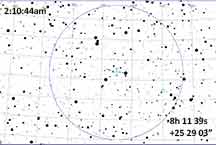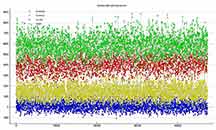

Kirk and I were about 1 asteroid radius apart, cross-track
This event has an RUWE of 3.95 which is rather large, so even though the centerline goes pretty close to my home, the odds of a hit are a bit of a wildcard. The other trouble is that it has a duration of only 0.3s. At 4x, minimum needed to see this star halfway decently, that's ony 1/12s per integration or .083 sec or 3-4 integrations maximum inside the event. It'll take good luck to get this event. It's clearing after the cold front, and it's high altitude at 78 degrees. Almost no chance for Karl, but some chance for me and Kirk. RUWE is 3.95 in OW and 5.15 in OWc. Tha's pretty high, so means an uncertain stellar position. OWcloud page
Here's the finder charts
 |
 |
Kirk and I were about 1 asteroid radius apart, cross-track |
I observed from outside my residence, under clear cold skies. I disconnected the external LCD monitor so that all video signal would go into the DV camcorder, to improve S/N a bit, My PyMovie reduction shows a single-integration event less than 1.6s before the (rounded) predicted event time of 10:10:44 UT. Since the RUWE=4 or 5, an offset of this is not unexpected. Nominal odds (w/o considering RUWE) were 40% for a positive, as I was near the centerline. I used a Watec 4x setting or .08s per PAL integration.
 |
 |
 |
 |
 |
|
"Detectability" was apparently programmed to mean a 5-sigma certainty of an event, from what I can gather. The single integration drop to zero, at a moment when all other stars sampled show nothing unusual, and only 1.6s from the predicted time, is suspiously genuine. The 4x setting gives 1/12 second time resolution for a 3/12s long predicted maximum event. But the data quality is good. No other drops are lower than 40% of the mean. |
The PyOTE detectability test says I'd need 2 intervals to have a detection. I have only 1 interval with an occultation. A single-point drop of 4.5 magnitudes; essentially zero, as predicted. |
Same plot as at left, zoomed in. These are randomly generated points with the same noise as the real data outside the occultation, and then a sample occultation of the stated depth inserted if detectable. |
The histogram of drop outs from random noise, which looks rather strange to me because in fact out of 1,440 integrations recorded, there are none (except the suspected occultation) lower than 40% of mean. The red bar looks significantly too far left into the blue hump to be correct. The area under the blue curve to the right of the red line here is, by eye, roughly 3%, not the one chance in 1,440 data points (=.07%), and right at the predicted occultation moment, which is the reality. |
Is the single point drop a real occultation? Probably yes, is my judgement after looking at all of this.
My case: No other drops are deeper than 40% of the mean. Only this single 2-frame integration point drops 4.5 magnitudes to zero as the predictions say it should, and ~at the predicted time. No reference stars show any unusual rise or drop in brightness at this time. The "detectability" test is obscure on what "detectable" means. What sigma-level is assumed to be a detection? The policy of the auditors has been 5 - sigma (<1/50,000 chance it's random noise) but this does NOT include the probability that this event happens so close to the predicted time. The odds of a drop at the right time, to within 2 seconds out of 120 seconds of data, multiplies the odds for validity that it is genuine by another factor of ~60.). Are we to throw this out on foolish statistical obstinance? When it could be used to help make better predictions for additional occultations and motivate new observations with tighter confidence limits? I say no. What will the auditor's say? So far, I do not see it in the IOTA Results page.
Now, if the predicted occultation were several seconds or longer, the odds that of all occultations possible that I could have had, that I'd be so close to the northern or southern limit as to have an event that short, would be an argument against its reality; that short an event would require it be a near graze. And that's because the fraction of the available diameter of the asteroid that could produce such a short event is quite small compared to other longer occultation durations. The PyOTE odds calculations do not include this effect. But the OWcloud prediction page linked at top, says the predicted maximum duration is only 0.3 seconds, and then a 1/12s (PAL frame rate) means 2x=4frames=2x1/25fps = 1/12 second) and so the suspected occultation event is 28% of the full expected duration, and so is rather reasonable in odds.
My decision is to report it as a short single full integration positive, and then I will let the auditors have to take responsibility for throwing it away.
One last point - since the RUWE is so large, the star position has more than typical uncertainty for GAIA, and that directly means the asteroid astrometry from this event will then be similarly limited in accuracy. So for now (pending a better RUWE on this star), it may make more limited difference in improving the orbit of asteroid Barryburke..
Timings:
The single drop point has adjacent points that are both above the mean brightness (Fresnel diffraction? No stellar diameter is given in OWc, but the non-reddish color suggests this ia a main sequence star and hence of small diameter, so that Fresnel diffraction might be involved). So this suggests the mid point of the occultation was at the midpoint of that frame. I will report the early time stamp of the zero frame (frame #1408 with time stamp 10:10:42.2395) as the D and the early time stamp of the second field of the integration (frame #1409 at 10:10:42.2795UT ) as the time of the R. The 1-sigma, 2-sigma, 3-sigma confidence limits are gut-level estimates from my experience with PyOTE.
|
Here's a screen capture of the relevant place in the PyMovie Excel output |
| UT of early time stamp for this frame | 1sigma | 2sigma | 3-sigma | |
| D | 10:10:42.2395 | .01s | .02s | .03s |
| R | 10:10:42.2795 | .01s | .02s | .03s |
time and it doesn't go down near the no-star level.
 |
 |
 |
Again, not surprising that Kirk's record shows a miss at his station. We were a full asteroid radius apart, my drop, if real, suggests the centerline was NE of me, not SW of me.
IOTA report send in 1/18/24